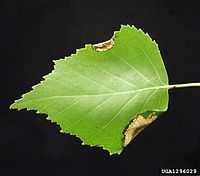Parornix betulae
| Parornix betulae | |
|---|---|
| | |
| Scientific classification | |
| Kingdom: | Animalia |
| Phylum: | Arthropoda |
| Class: | Insecta |
| Order: | Lepidoptera |
| Family: | Gracillariidae |
| Genus: | Parornix |
| Species: | P. betulae |
| Binomial name | |
| Parornix betulae (Stainton, 1854)[1] | |
| Synonyms | |
| |
Parornix betulae is a moth of the Gracillariidae family. It is known from all of Europe (except the Iberian Peninsula, the Balkan Peninsula and the Mediterranean Islands), east to Korea.

The wingspan is 9–10 mm. Adults are on wing in May and August.[2]
The larvae feed on Betula alleghaniensis, Betula grossa, Betula humilis, Betula obscura, Betula papyrifera, Betula pendula, Betula pubescens, Betula nana and Betula utilis. They mine the leaves of their host plant. The mine starts as an inconspicuous lower surface corridor, mainly recognisable by its brown line of frass. In the next larval stage a lower-surface blotch is made, that soon develops into a tentiform mine. The frass is deposited in a clump in a corner of the mine. After leaving the mine the larva continues feeding in a downwards folded leaf margin, that is fixed with silk.[3]